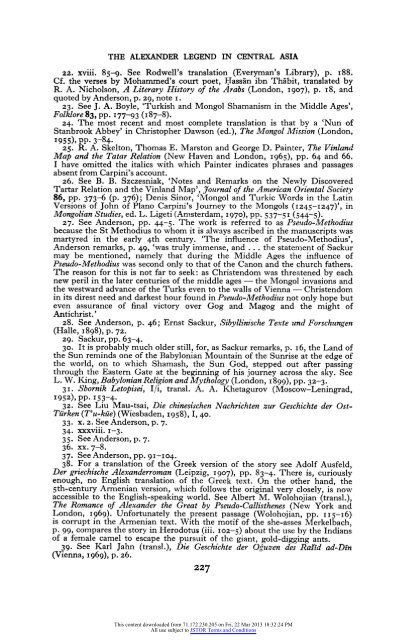The Alexander Legend in Central Asia
The Alexander Legend in Central Asia
The Alexander Legend in Central Asia
Create successful ePaper yourself
Turn your PDF publications into a flip-book with our unique Google optimized e-Paper software.
THE ALEXANDER LEGEND IN CENTRAL ASIA<br />
22. xviii. 85-9. See Rodwell's translation (Everyman's Library), p. 188.<br />
Cf. the verses by Mohammed's court poet, IIass<strong>in</strong> ibn Thdbit, translated by<br />
R. A. Nicholson, A Literary History of the Arabs (London, I907), p. i8, and<br />
quoted by Anderson, p. 29, note i.<br />
23. See J. A. Boyle, 'Turkish and Mongol Shamanism <strong>in</strong> the Middle Ages',<br />
Folklore 83, pp. 177-93 (187-8).<br />
24. <strong>The</strong> most recent and most complete translation is that by a 'Nun of<br />
Stanbrook Abbey' <strong>in</strong> Christopher Dawson (ed.), <strong>The</strong> Mongol Mission (London,<br />
1955), PP. 3-84.<br />
25. R. A. Skelton, Thomas E. Marston and George D. Pa<strong>in</strong>ter, <strong>The</strong> V<strong>in</strong>land<br />
Map and the Tatar Relation (New Haven and London, 1965), pp. 64 and 66.<br />
I have omitted the italics with which Pa<strong>in</strong>ter <strong>in</strong>dicates phrases and passages<br />
absent from Carp<strong>in</strong>i's account.<br />
26. See B. B. Szczesniak, 'Notes and Remarks on the Newly Discovered<br />
Tartar Relation and the V<strong>in</strong>land Map', Journal of the American Oriental Society<br />
86, pp. 373-6 (p. 376); Denis S<strong>in</strong>or, 'Mongol and Turkic Words <strong>in</strong> the Lat<strong>in</strong><br />
Versions of John of Plano Carp<strong>in</strong>i's Journey to the Mongols (1245-1247)', <strong>in</strong><br />
Mongolian Studies, ed. L. Ligeti (Amsterdam, 1970), pp. 537-51 (544-5).<br />
27. See Anderson, pp. 44-5. <strong>The</strong> work is referred to as Pseudo-Methodius<br />
because the St Methodius to whom it is always ascribed <strong>in</strong> the manuscripts was<br />
martyred <strong>in</strong> the early 4th century. '<strong>The</strong> <strong>in</strong>fluence of Pseudo-Methodius',<br />
Anderson remarks, p. 49, 'was truly immense, and . . . the statement of Sackur<br />
may be mentioned, namely that dur<strong>in</strong>g the Middle Ages the <strong>in</strong>fluence of<br />
Pseudo-Methodius was second only to that of the Canon and the church fathers.<br />
<strong>The</strong> reason for this is not far to seek: as Christendom was threatened by each<br />
new peril <strong>in</strong> the later centuries of the middle ages - the Mongol <strong>in</strong>vasions and<br />
the westward advance of the Turks even to the walls of Vienna - Christendom<br />
<strong>in</strong> its direst need and darkest hour found <strong>in</strong> Pseudo-Methodius not only hope but<br />
even assurance of f<strong>in</strong>al victory over Gog and Magog and the might of<br />
Antichrist.'<br />
28. See Anderson, p. 46; Ernst Sackur, Sibyll<strong>in</strong>ische Texte und Forschungen<br />
(Halle, I898), p. 72.<br />
29. Sackur, pp. 63-4.<br />
30. It is probably much older still, for, as Sackur remarks, p. I6, the Land of<br />
the Sun rem<strong>in</strong>ds one of the Babylonian Mounta<strong>in</strong> of the Sunrise at the edge of<br />
the world, on to which Shamash, the Sun God, stepped out after pass<strong>in</strong>g<br />
through the Eastern Gate at the beg<strong>in</strong>n<strong>in</strong>g of his journey across the sky. See<br />
L. W. K<strong>in</strong>g, Babylonian Religion and Mythology (London, 1899), pp. 32-3.<br />
31. Sbornik Letopisei, I/i, transl. A. A. Khetagurov (Moscow-Len<strong>in</strong>grad,<br />
1952), pp. 153-4.<br />
32. See Liu Mau-tsai, Die ch<strong>in</strong>esischen Nachrichten zur Geschichte der Ost-<br />
Tiirken (T'u-kiie) (Wiesbaden, 1958), I, 40.<br />
33. x. 2. See Anderson, p. 7.<br />
34. xxxviii. 1-3.<br />
35. See Anderson, p. 7.<br />
36. xx. 7-8.<br />
37- See Anderson, pp. 91-104.<br />
38. For a translation of the Greek version of the story see Adolf Ausfeld,<br />
Der griechische <strong>Alexander</strong>roman (Leipzig, 1907), pp. 83-4. <strong>The</strong>re is, curiously<br />
enough, no English translation of the Greek text. On the other hand, the<br />
5th-century Armenian version, which follows the orig<strong>in</strong>al very closely, is now<br />
accessible to the English-speak<strong>in</strong>g world. See Albert M. Wolohojian (transl.),<br />
<strong>The</strong> Romance of <strong>Alexander</strong> the Great by Pseudo-Callisthenes (New York and<br />
London, 1969). Unfortunately the present passage (Wolohojian, pp. ii5-16)<br />
is corrupt <strong>in</strong> the Armenian text. With the motif of the she-asses Merkelbach,<br />
p. 99, compares the story <strong>in</strong> Herodotus (iii. oz2-5) about the use by the Indians<br />
of a female camel to escape the pursuit of the giant, gold-digg<strong>in</strong>g ants.<br />
39. See Karl Jahn (transl.), Die Geschichte der Oguzen des Rarid ad-D<strong>in</strong><br />
(Vienna, 1969), p. 26.<br />
227<br />
This content downloaded from 71.172.230.205 on Fri, 22 Mar 2013 18:32:24 PM<br />
All use subject to JSTOR Terms and Conditions
















